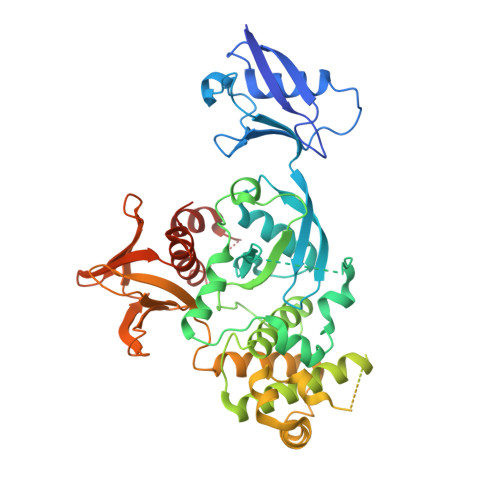Structure basis of the FERM domain of kindlin-3 in supporting integrin alpha IIb beta 3 activation in platelets.
Sun, J., Xiao, D., Ni, Y., Zhang, T., Cao, Z., Xu, Z., Nguyen, H., Zhang, J., White, G.C., Ding, J., Ma, Y.Q., Xu, Z.(2020) Blood Adv 4: 3128-3135
- PubMed: 32649767
- DOI: https://doi.org/10.1182/bloodadvances.2020001575
- Primary Citation of Related Structures:
6V97, 6V9G - PubMed Abstract:
Kindlin-3, a protein 4.1, ezrin, radixin, and moesin (FERM) domain-containing adaptor in hematopoietic cells, is essentially required for supporting the bidirectional integrin αIIbβ3 signaling in platelets by binding to the integrin β3 cytoplasmic tail. However, the structural details of kindlin-3's FERM domain remain unknown. In this study, we crystalized the kindlin-3's FERM domain protein and successfully solved its 3-dimensional structure. The structure shows that the 3 kindlin-3's FERM subdomains (F1, F2, and F3) compact together and form a cloverleaf-shaped conformation, which is stabilized by the binding interface between the F1 and F3 subdomains. Interestingly, the FERM domain of kindlin-3 exists as a monomer in both crystal and solution, which is different from its counterpart in kindlin-2 that is able to form a F2 subdomain-swapped dimer; nonetheless, dimerization is required for kindlin-3 to support integrin αIIbβ3 activation, indicating that kindlin-3 may use alternative mechanisms for formation of a functional dimer in cells. To evaluate the functional importance of the cloverleaf-like FERM structure in kindlin-3, structure-based mutations were introduced into kindlin-3 to disrupt the F1/F3 interface. The results show that integrin αIIbβ3 activation is significantly suppressed in platelets expressing the kindlin-3 mutant compared with those expressing wild-type kindlin-3. In addition, introduction of equivalent mutations into kindlin-1 and kindlin-2 also significantly compromises their ability to support integrin αIIbβ3 activation in CHO cells. Together, our findings suggest that the cloverleaf-like FERM domain in kindlins is structurally important for supporting integrin αIIbβ3 activation.
Organizational Affiliation:
Collaborative Research Program for Cell Adhesion Molecules, Shanghai University School of Life Sciences, Shanghai, China.













